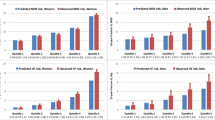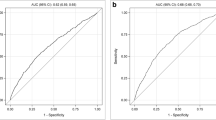Abstract
Summary
In a large clinical registry for the province of Manitoba, Canada, FRAX predicted incident MOF and hip fracture from 1 to 15 years following baseline assessment. A simple linear rescaling of FRAX outputs seems useful for predicting both short- and long-term fracture risk in this population.
Introduction
FRAX® estimates 10-year probability of major osteoporotic fracture (MOF) and hip fracture. We examined FRAX predictions over intervals shorter and longer than 10 years.
Methods
Using a population-based clinical registry for Manitoba, Canada, we identified 62,275 women and 6455 men 40 years and older with baseline dual-energy X-ray absorptiometry scans and FRAX scores. Incident MOF and hip fracture were assessed up to 15 years from population-based data. We assessed agreement between estimated fracture probability from 1 to 15 years using linearly rescaled FRAX scores and observed cumulative fracture probability. The gradient of risk for FRAX probability and incident fracture was examined overall and for 5-year intervals.
Results
FRAX predicted incident MOF and hip fracture for all time intervals. There was no attenuation in the gradient of risk for MOF even for years >10. Gradient of risk was slightly lower for hip fracture prediction in years >10 vs years <5, though HRs remained high. Linear agreement was seen in the relationships between observed vs predicted (rescaled) FRAX probabilities (R 2 0.95–1.00). Among women, there was near-perfect linearity in MOF predictions. Deviations from linearity, with a slightly higher observed than predicted MOF probability, were most evident in the first years following a fracture event and after 10 years for hip fracture prediction in women using FRAX with BMD. Simulations showed that results were robust to large differences in fracture rates and moderate differences in mortality rates.
Conclusions
FRAX predicts incident MOF and hip fracture up to 15 years and could be adapted to predict fracture over time periods shorter and longer term than 10 years in populations with fracture and mortality epidemiology similar to Canada.



Similar content being viewed by others
References
NIH Consensus Development Panel (2001) Osteoporosis prevention, diagnosis, and therapy. JAMA 285:785–795
MacLean C, Newberry S, Maglione M et al (2008) Systematic review: comparative effectiveness of treatments to prevent fractures in men and women with low bone density or osteoporosis. Ann Intern Med 148:197–213
Hopkins RB, Goeree R, Pullenayegum E et al (2011) The relative efficacy of nine osteoporosis medications for reducing the rate of fractures in post-menopausal women. BMC Musculoskelet Disord 12:209
Leslie WD, Lix LM (2014) Comparison between various fracture risk assessment tools. Osteoporos Int 25:1–21
Kanis JA (2007) On behalf of the World Health Organization Scientific Group. Assessment of osteoporosis at the primary health-care level. Technical report. Accessible at http://www.shef.ac.uk/FRAX/pdfs/WHO_Technical_Report.pdf. Published by the University of Sheffield
Satagopan JM, Ben-Porat L, Berwick M et al (2004) A note on competing risks in survival data analysis. Br J Cancer 91:1229–1235
Kanis JA, Harvey NC, Cooper C et al (2016) A systematic review of intervention thresholds based on FRAX : a report prepared for the National Osteoporosis Guideline Group and the International Osteoporosis Foundation. Arch Osteoporos 11:25–0278
Cummings SR, Cosman F, Eastell R et al (2013) Goal-directed treatment of osteoporosis. J Bone Miner Res 28:433–438
Nguyen ND, Frost SA, Center JR et al (2007) Development of a nomogram for individualizing hip fracture risk in men and women. Osteoporos Int 18:1109–1117
Nguyen ND, Frost SA, Center JR et al (2008) Development of prognostic nomograms for individualizing 5-year and 10-year fracture risks. Osteoporos Int 19:1431–1444
Hippisley-Cox J, Coupland C (2009) Predicting risk of osteoporotic fracture in men and women in England and Wales: prospective derivation and validation of QFractureScores. BMJ 339:b4229
Hippisley-Cox J, Coupland C (2012) Derivation and validation of updated QFracture algorithm to predict risk of osteoporotic fracture in primary care in the United Kingdom: prospective open cohort study. BMJ 344:e3427
Bynum JP, Bell JE, Cantu RV et al (2016) Second fractures among older adults in the year following hip, shoulder, or wrist fracture. Osteoporos Int 27:2207–2215
Giangregorio LM, Leslie WD (2010) Time since prior fracture is a risk modifier for 10-year osteoporotic fractures. J Bone Miner Res 25:1400–1405
Leslie WD, MacWilliam L, Lix L et al (2005) A population-based study of osteoporosis testing and treatment following introduction of a new bone densitometry service. Osteoporos Int 16:773–782
Leslie WD, Caetano PA, MacWilliam LR et al (2005) Construction and validation of a population-based bone densitometry database. J Clin Densitom 8:25–30
Looker AC, Wahner HW, Dunn WL et al (1998) Updated data on proximal femur bone mineral levels of US adults. Osteoporos Int 8:468–489
Leslie WD, Lix LM, Langsetmo L et al (2011) Construction of a FRAX((R)) model for the assessment of fracture probability in Canada and implications for treatment. Osteoporos Int 22:817–827
Leslie WD, Lix LM, Johansson H et al (2010) Independent clinical validation of a Canadian FRAX tool: fracture prediction and model calibration. J Bone Miner Res 25:2350–2358
Fraser LA, Langsetmo L, Berger C et al (2011) Fracture prediction and calibration of a Canadian FRAX(R) tool: a population-based report from CaMos. Osteoporos Int 22:829–837
Dagan N, Cohen-Stavi C, Leventer-Roberts M et al (2017) External validation and comparison of three prediction tools for risk of osteoporotic fractures using data from population based electronic health records: retrospective cohort study. BMJ 356:i6755. doi:10.1136/bmj.i6755.:i6755
WHO Collaborating Centre for Drug Statistics Methodology (eds) (2005) Guidelines for ATC classification and DDD assignment. Oslo
Leslie WD, Lix LM, Johansson H et al (2012) Does osteoporosis therapy invalidate FRAX for fracture prediction? J Bone Miner Res 27:1243–1251
Leslie WD, Tsang JF, Caetano PA et al (2007) Effectiveness of bone density measurement for predicting osteoporotic fractures in clinical practice. J Clin Endocrinol Metab 92:77–81
Roos NP, Shapiro E (1999) Revisiting the Manitoba Centre for Health Policy and Evaluation and its population-based health information system. Med Care 37:JS10–JS14
Leslie WD, Lix LM, Wu X (2013) Competing mortality and fracture risk assessment. Osteoporos Int 24:681–688
Lam A, Leslie WD, Lix LM et al (2014) Major osteoporotic to hip fracture ratios in Canadian men and women with Swedish comparisons: a population-based analysis. J Bone Miner Res 29:1067–1073
Johnell O, Kanis JA, Oden A et al (2004) Mortality after osteoporotic fractures. Osteoporos Int 15:38–42
Morin S, Lix LM, Azimaee M et al (2011) Mortality rates after incident non-traumatic fractures in older men and women. Osteoporos Int 22:2439–2448
Lindsay R, Silverman SL, Cooper C et al (2001) Risk of new vertebral fracture in the year following a fracture. JAMA 285:320–323
Lix LM, Azimaee M, Osman BA et al (2012) Osteoporosis-related fracture case definitions for population-based administrative data. BMC Public Health 12:301
O’Donnell S (2013) Use of administrative data for national surveillance of osteoporosis and related fractures in Canada: results from a feasibility study. Arch Osteoporos 8:143
McClung MR (2012) To FRAX or not to FRAX. J Bone Miner Res 27:1240–1242
Bolland MJ, Grey AB, Gamble GD et al (2010) Effect of osteoporosis treatment on mortality: a meta-analysis. J Clin Endocrinol Metab 95:1174–1181
Acknowledgments
The authors acknowledge the Manitoba Centre for Health Policy for use of data contained in the Population Health Research Data Repository (HIPC 2011/2012-31). The results and conclusions are those of the authors and no official endorsement by the Manitoba Centre for Health Policy, Manitoba Health, Seniors and Active Living, or other data providers is intended or should be inferred. This article has been reviewed and approved by the members of the Manitoba Bone Density Program Committee.
SNM is chercheur-boursier des Fonds de Recherche du Québec en Santé. LML is supported by a Manitoba Health Research Chair. SRM holds the Endowed Chair in Patient Health Management (Faculties of Medicine and Dentistry and Pharmacy and Pharmaceutical Sciences, University of Alberta).
Author information
Authors and Affiliations
Corresponding author
Ethics declarations
Funding
No funding support was received for this research project.
Conflicts of interest
Suzanne Morin: Consultant to: Amgen; Research Grants: Amgen, Merck.
John A. Kanis: Grants from Amgen, grants from Lilly, non-financial support from Medimaps, grants from Unigene, non-financial support from Asahi, grants from Radius Health, outside the submitted work. Dr. Kanis is the architect of FRAX but has no financial interest. Governmental and NGOs: National Institute for health and clinical Excellence (NICE), UK; International Osteoporosis Foundation; INSERM, France; Ministry of Public Health, China; Ministry of Health, Australia; Ministry of Health, Abu Dhabi; National Osteoporosis Guideline Group, UK; WHO.
Eugene McCloskey: Nothing to declare for FRAX and the context of this paper, but numerous ad hoc consultancies/speaking honoraria and/or research funding from Amgen, Bayer, General Electric, GSK, Hologic, Lilly, Merck Research Labs, Novartis, Novo Nordisk, Nycomed, Ono, Pfizer, ProStrakan, Roche, Sanofi-Aventis, Servier, Tethys, UBS and Warner-Chilcott.
William Leslie, Sumit Majumdar, Lisa Lix, H. Johansson, A. Oden: None.
Electronic supplementary material
Supplemental Table 1
(DOCX 17 kb)
Supplemental Table 2
(DOCX 17 kb)
Supplemental Table 3
(DOCX 18 kb)
Supplemental Figure 1
(DOCX 21 kb)
Supplemental Figure 2
(DOCX 26 kb)
Supplemental Figure 3
(DOCX 26 kb)
Supplemental Figure 4
(DOCX 26 kb)
Supplemental Figure 5
(DOCX 26 kb)
Rights and permissions
About this article
Cite this article
Leslie, W.D., Majumdar, S.R., Morin, S.N. et al. FRAX for fracture prediction shorter and longer than 10 years: the Manitoba BMD registry. Osteoporos Int 28, 2557–2564 (2017). https://doi.org/10.1007/s00198-017-4091-3
Received:
Accepted:
Published:
Issue Date:
DOI: https://doi.org/10.1007/s00198-017-4091-3




